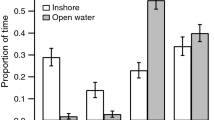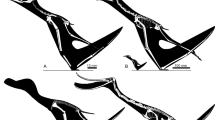Summary
-
1.
The review is concerned mainly with exocoetid flying fish, because little reliable information is available concerning other groups.
-
2.
Adult flying fish are of variable size (150–500 mm maximum length) and may be broadly divided into two categories: ‘two-wingers’ (e.g.Fodiator, Exocoetus, Parexocoetus) in which the enlarged pectoral fins make up most of the lifting surfaces, and ‘four-wingers’ (e.g.Cypsilurus, Hirundichthys) in which both pectoral and pelvic fins are hypertrophied.
-
3.
The pectoral girdle of flying fish is considerably enlarged by comparison with most teleosts, the coracoid and scapula being particularly hypertrophied.
-
4.
The pectoral fins are controlled by two groups of muscles, the lateral muscles that extend the wings, and the medial muscles that furl them. Both groups appear from external appearances to be red (aerobic) muscles.
-
5.
A general picture of the flight of an adult four-wing flying fish is presented: fish swim toward the surface at very high speed (< 30 body lengths s-1) with the lateral fins furled, leap through the water surface at a shallow angle, accelerate to take-off speed by taxiing with the lateral fins expanded and the tail beating in the water at up to 50 beats s-1, and enter a free flight that may be prolonged by further taxiing.
-
6.
Flying fish do not flap their wings to gain lift, but a whirring noise oroduced during take-off is possibly due to fluttering caused by the coupling together of the contraction of the axial muscles in the production of tail movements, and the action of the pectoral muscles in moving the pectoral fin rays. Alternatively, the noise may be due to a passive, flag-like function of the wings, stemming from their relatively rigid leading edges and flexible trailing edges.
-
7.
Flying fish grow in slightly (but significantly) negatively allometric fashion, becoming slimmer with increased body length. On the other hand, wingloading has a markedly positive allometric relationship with standard length because flying fish cannot increase relative wingspan during growth, but have to narrow the wings to improve performance as they fly at greater speeds. Wingloading of flying fish is similar to that of birds and bats, and the largest of flying fish exhibit wingloadings similar to cormorants and pelicans.
-
8.
The expanded, flat pelvic fins of four-wingers have evolved, not to increase wing area, but to function as ‘tailplanes’ or ‘stabilizers’ well behing the centre of gravity, with an area some 20–35% of the total lateral fin area, and an angle of incidence less than that of the cambered pectoral fins.
-
9.
Flying fish start to exhibit flight at a length of around 50 mm; at smaller sizes surface tension is of importance, limiting flying fish to simple leaps with the fins held against the body by surface tension. Evidence is presented to indicate that smaller flying fish gain positive benefits to their swimming performance from possession of expanded lateral fins.
-
10.
For a flying fish of 0.3 m standard length, significant reduction of drag by ground effect will take place at heights below about 0.5 m, prolonging flights and helping take-off.
-
11.
Flying fish are in general limited to surface waters warmer than 20–23 °C. Evidence is presented to show that it is unlikely that flying fish are capable of flight at temperatures below 20 °C because of fundamental limitations of muscle function.
-
12.
The most recent cladistic analysis supports the view that flying fish evolved from half-beak-like ancestors. They probably developed from elongate epipelagic fishes with hypocercal tails that helped them to swim quickly in the near-surface high-drag zone.
-
13.
Flying fish probably fly mainly to escape from predators, particularly dolphin-fishes (Coryphaena hippurus) and ommastrephid squid. An alternative hypothesis of energy conservation is rejected; other possibilities (e.g. migration between food-poor and food-rich areas) are at present supported by limited evidence.
Similar content being viewed by others
References
Arita, G.S. (1971) A re-examination of the functional morphology of the soft-rays in teleosts.Copeia,1971, 691–7.
Au, D. and Weihs, D. (1980) At high speeds dolphins save energy by leaping.Nature, Lond. 284, 348–50.
Baylor, E.R. (1967) Air and water vision of the Atlantic flying fish.Cypselurus heterurus.Nature, Lond. 214, 307–9.
Beamish, F.W.H. (1978) Swimming capacity. In W.S., Hoare and D.J., Randall eds.Fish Physiology Vol. 7. New York: Academic Press, pp. 101–87.
Belokopytin, Y.S. and Abolmasova, G.A. (1988) Energetics of metabolism of flying fishes of the tropical Atlantic at various rates of swimming.J. Ichthyol. 28, 148–51.
Bilinski, E. (1974) Biochemical aspects of fish swimming. In D.C., Malins and J.R., Sargent, eds.Biochemical and Biophysical Perspectives in Marine Biology,Vol. 1. New York: Academic Press, pp. 239–88.
Blake, R.W.. (1983)Fish Locomotion, Cambridge: Cambridge Univ. Press. 208 pp.
Bone, Q. (1966) On the function of the two types of myotomal muscle fibre in elasmobranch fish.J. mar. biol. Ass. UK 46, 321–49.
Bone, Q. (1978) Locomotor muscle. In W.S., Hoare and D.J., Randall eds.Fish Physiology Vol. 7. New York: Academic Press, pp. 361–424.
Breder, C.M.jun. (1929) Field observations on flying fishes; a suggestion of methods.Zoologica 9, 295–312.
Breder, C.M.jun. (1930) On the structural specialization of flying fishes from the standpoint of aerodynamics.Copeia 4 114–21.
Breder, C.M.jun. (1937) The perennial flying fish controversy.Science 86 (2236), 420–22.
Breder, C.M.jun. (1938) A contribution to the life histories of Atlantic Ocean flying fishers.Bull. Bingham Oceanogr. Coll. 6, 1–126.
Bruun, A. Fr. (1935) Flying-fishes (Exocoetidae) of the Atlantic. Systematic and biological studies.Dana Rep. 2 (6), 106 pp., 7 plates.
Calderwood, W.L. (1891) On the swimming bladder and flying powers ofDactylopterus volitans.Proc. R. Soc. Edinb. 17, 132–8.
Carter, G.S. and Mander, J.A.H. (1935) The flight of the flying fishExocoetus.Rep. Brit. Ass. Adv. Sci. 105, 383–4.
Collette, B.B., McGowen, G.E., Parin, N.V. and Mito, S. (1984) Beloniformes: development and relationships.Spec. Publ. Am. Soc. Ichthyol. Herpetol. 1, 335–54.
Davenport, J. (1990) Observations on the locomotion of post-larval and juvenile flying fish.J. mar. biol. Ass UK 70, 311–20.
Davenport, J. (1992) Wingloading, stability and morphometric relationships in flying fish (Exocoetidae) from the north-eastern Atlantic.J. mar. biol. Ass. UK 72, 25–39.
Davenport, J. and Rees, E.I.S. (1993) Observations on neuston and floating weed patches in the Irish Sea.Est. coast. Shelf Sci. 36, 395–411.
Dowd, R.E. (1921) The aeronautics of the flying fish.Aerial Age Weekly (10 Jan. 1921), 464–5.
Durnford, C.D. (1906) Flying-fish flight, and an unfixed law of nature.Am. Nat. 40, 1–11.
Edgerton, H.E. and Breder, C.M.jun. (1941) High speed photographs of flying fishes in flight.Zoologica (NY)26, 311–13.
Fish, F.E. (1981) Wing loading in flying fish. [abstract]Am. Zool. 21, 937.
Fish, F.E. (1990) Wing design and scaling of flying fish with regard to flight performance.J. Zool., Lond. 221, 391–403.
Franzisket, L. (1965) Beobachtungen und messungen am flug der fliegenden fische.Zool. Jb. (Physiol.) 70, 235–40. (in German)
Gill, T. (1863) Notes on the genera of Hemiramphinae.Proc. Acad. nat. Sci. Philad.1863.
Gill, T. (1905) Flying fish and their habits.Ann. Rep. Smithsonian Inst. 1904, 495–515.
Greenwood, P.H. and Thomson, K.S. (1960) The pectoral anatomy ofPantodon bucholzi Peters (a freshwater flying fish) and the related Osteoglossidae.Proc. zool. Soc. Lond. 135, 283–301.
Hankin, E.H. (1920) Observations on the flight of flying fishes.Proc zool. Soc. Lond. 2, 467–74.
Hertel, H. (1966)Structure-Form-Movement. New York: Reinhold. 251 pp.
Hesse, R. (1924) Tiergeographie auf ökoligischer Grundlage. Jena. Seen in authorized, rewritten translation: Hesse, R. (1937)Ecological Animal Geography (prepared by Allee, W.C. and Schmidt, K.P.). New York: John Wiley & Sons, 597 pp.
Hildebrand, M. (1982)Analysis of Vertebrate Function, 2nd edn. New York: John Wiley and Sons. 654 pp.
Hoernes, H. (1913) Über Flügelformen und Körper fliegender Fische.Zeitschrift für Flugtechnik u. Motorluftschiff-fart 4, 299–304 and 325–33.
Hubbs, C.L. (1918) The flight of the California flying fish.Copeia No. 62, 85–8.
Hubbs, C.L. (1933) Observations on the flight of fishes, with a statistical study of the flight of the Cypselurinae and remarks on the evolution of flight of fishes.Pap. Michigan Acad. Sci., Art., Lett. 17, 575–611.
Hubbs, C.L. (1937) Further observations and statistics on the flight of fishes.Pap. Michigan Acad. Sci., Art., Lett. 22, 641–60.
Johnston, I.A., Frearson, N. and Goldspink, G. (1972) Myofibrillar ATPase activities of red and white muscles of marine fish.Experientia 28, 713–14.
Linnaeus, C.V. (1758)Systema Naturae,Vol. 1. Edn. 10. Holmiae. 826 pp.
Marshall, N.B. (1965)The Life of Fishes. London: Weidenfield and Nicolson. 402 pp.
Mills, C.A. (1936) Source of propulsive power used by flying fish.Science 83, 80.
Möbius, K. (1878) Die bewegungen der fliegenden fische durch die luft.Z. wiss. Zool. (Suppl.) 30, 343–82. (in German)
Nicholas, J.T. and Breder, C.M.jun. (1928) About flying fishes.Nat. Hist. 28, 64–77.
Norman, J.R. (1966) A draft synopsis of the orders, families and genera of recent fishes and fish-like vertebrates. Trustees of the British Museum (Natural History).
Parin, N.V. (1961) Principles of classification of flying fishes (Oxyporhamphidae and Exocoetidae).Trudy Inst. Oceanol. 43, 92–183.
Rayner, J.M.V. (1985) Linear relations in biomechanics: the statistics of scaling functions.J. Zool., Lond. 206, 415–39.
Rayner, J.M.V. (1986) Pleuston: animals which move in water and air.Endeavour, N. Ser. 10 (2), 58–64.
Rayner, J.M.V. (1991) On the aerodynamics of animal flight in ground effect.Phil. Trans. R. Soc. 334B, 119–28.
Regan, C.T. (1911) The classification of the teleostean fishes of the Order Synentognathi.Ann. Mag. Nat. Hist. 7 (Series 8), No. 40. London.
Ridewood, W.G. (1913) Notes on the South American freshwater flying fishGasteropelecus, and the common flying fish,Exocoetus.Ann. Mag. nat. Hist. 12, 544–8, pl. 16.
Schott, G. (1926) Geographie des Atlantischen Ozeans. 2. Auflage. Hamburg. 368 pp. (in German)
Shadbolt, L. (1908) On the flying fish.Aeronautical J., (Oct. 1908), 111–14.
Shoulejkin, W. (1929) Airdynamics of the flying fish.Int. Rev. ges. Hydrobiol. Hydrog. 22, 102–10.
Videler, J.J. (1993)Fish Swimming. London: Chapman & Hall. 260 pp.
Wardle, C.S. (1975) Limits of fish swimming speed.Nature, Lond. 255, 725–7.
Wardle, C.S. (1977) Effect of size on swimming speeds of fish. In Padley, T.J., ed.Scale Effects in Animal Locomotion. London: Academic Press, pp. 299–313.
Weitzman, S.H. (1945) The osteology and relationships of the South American characid fishes of the subfamily Gasteropelecinae.Stanford Ichthyol. Bull. 4, 211–63.
Author information
Authors and Affiliations
Rights and permissions
About this article
Cite this article
Davenport, J. How and why do flying fish fly?. Rev Fish Biol Fisheries 4, 184–214 (1994). https://doi.org/10.1007/BF00044128
Accepted:
Issue Date:
DOI: https://doi.org/10.1007/BF00044128




